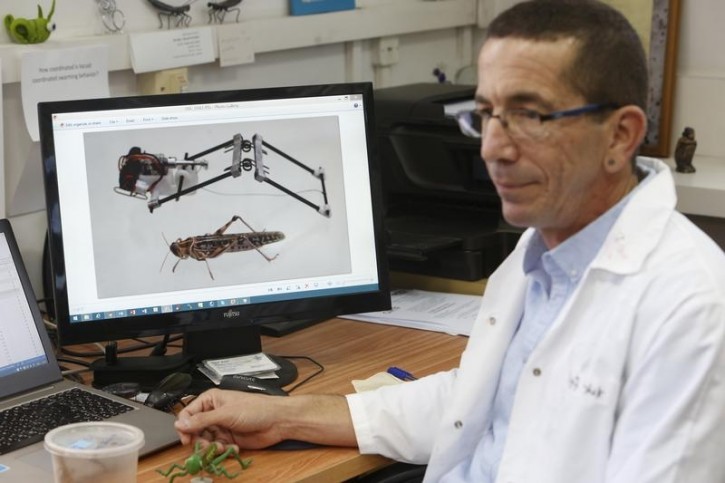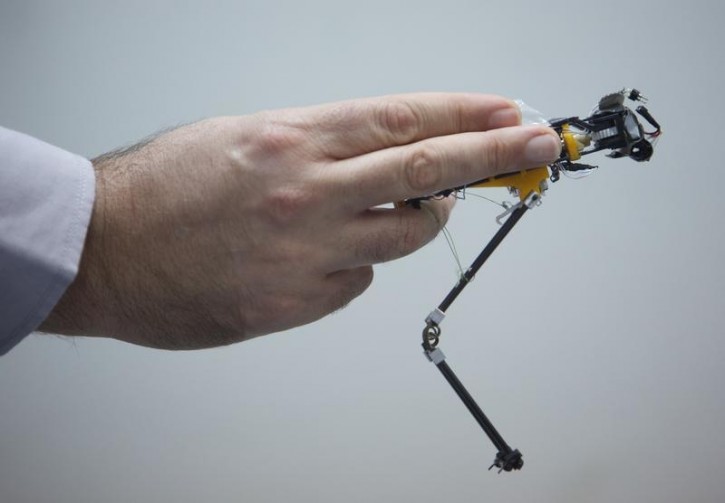 Tel Aviv – A locust-like robot could prove to be an inspired leap into the future of autonomous surveillance and emergency response systems.
Tel Aviv – A locust-like robot could prove to be an inspired leap into the future of autonomous surveillance and emergency response systems.
Subscribe to our Daily Roundup Email
Inspired by the locust’s jumping mechanism and elastic energy storage, Tel Aviv University researchers designed a tiny robot made from carbon rods, steel springs and 3D printed plastic pieces. It weighs less than once ounce (23 grams) and is approximately four inches (10 centimeters) long.
“The locust being a large insect that has wonderful jumping performance had offered itself as wonderful inspiration for this specific idea of a jumping…miniature jumping robot,” lead developer Professor Amir Ayali, of the Department of Zoology at Tel Aviv University’s Faculty of Life Sciences, told Reuters as he inspected a locust grown in his laboratory.
The robot can jump a remarkable 11.5 feet (3.5 meters), said Ayali, due to its structure and energy storage, which along with its motor makes it capable to withstand high accelerations.
“The locust uses mechanical energy in addition to its muscle force in order to generate a jump and this is exactly what we are imitating…We are using a tiny motor that generates, or stores mechanical energy, and this mechanical energy in springs is actually very similar to the locust legs is what propels the robot into the air,” said Ayali.
The bio-inspired robot, dubbed ‘TAUB’ (Tel Aviv University and Ort Braude College) was born out of an interdisciplinary collaboration between engineers and zoologists at the bequest of the Pearls of Wisdom Association for Research and advanced technology development in Israel.
Unlike drones that can be airborne for up to about 30 minutes, the locust robot is powered by a lithium battery. With its energy efficiency it can reach up to 1,000 jumps with only one battery loading.

Ayali said the robot could be easily mass produced since its parts are cheap and it is easy to manufacture, estimating the price of a robot at $100 USD.
From oil spills to rescue and surveillance operations, “what you do with it is whatever is needed whenever you want to engage any kind of robotic system with no human interference,” he said.
Ayali believes that with sufficient knowledge of locusts’ swarming capabilities, the robots may be capable of implementing the mechanisms of swarming capabilities in robotic systems.
Hungarian-born Doctor Gabor Kosa, of TAU’s Faculty of Engineering, a confessed sci-fi fan, envisages a swarm of robots installed with GPS navigation systems, cameras and solar panels for powering, entering enemy territory to carry out a surveillance operation.
Around $200,000 USD was invested in the project at its early stages. Ayali says the team is seeking more funding to develop it further.
Kosa hopes that with proper funding his team can build a robotic system capable of jumping multiple times and possibly even mimicking the locust by spreading its wings and flying.

What have all of the arab controlled countries given the world in the last 2 hundred years besides lots of spilled blood?
Perhaps artificial versions of each of the 10 plagues of Mitzrayim can be devised as weapons to use against the enemies of klal Yisroel! 🙂
Know what…Boruch Hashem that the closest enemies to Israel aren’t so smart and developed. Israel is surrounded by several countries who would like to destroy it and they aren’t able to do so, as they are too poor or under-developed. Boruch Hashem that Hashem made us superior against our enemies in so many ways, be it in armament development, technology, medicine and many different types of chochmos. Thank you Hashem, Thank you Hashem!